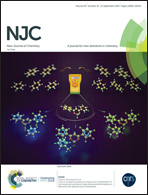Synthesis, screening and biological activity of potent thiosemicarbazone compounds as a tyrosinase inhibitor
Abstract
Tyrosinase plays an essential role in melanogenesis. Tyrosinase inhibition may not only be a means to alleviate skin hyperpigmentation, but also the most effective method for fruit and vegetable preservation. Thiosemicarbazone compounds have received enormous attention because of their potential therapeutic activities due to their antitumoral, antibacterial and antimalarial properties. In this study, we focused on the screening, toxicity, interaction and inhibitory activities of potent thiosemicarbazone compounds as novel tyrosinase inhibitors. The results showed that the inhibitor effectiveness was drastically reduced by the absence of the ortho-hydroxyl group and was improved by changing the substituents of benzaldehyde. To develop a pharmacophore model, we explored the binding mode of thiosemicarbazone compounds in the active site of tyrosinase. Docking analysis using an AUTODOCK program was conducted to explain the flexible thiosemicarbazone molecules binding with the active site of tyrosinase, because of their perfect match with both the active site and the substrate channel of tyrosinase in both size and hydrophobicity. Their binding was mainly stabilized via both the coordination of the sulfur and nitrogen atoms in the inhibitors to binuclear copper in the tyrosinase active site. Further complementary studies on these types of inhibitors, such as for potential drug candidates for treating abnormal melanin pigmentation and inhibiting food or fruit browning, are still needed.



 Please wait while we load your content...
Please wait while we load your content...